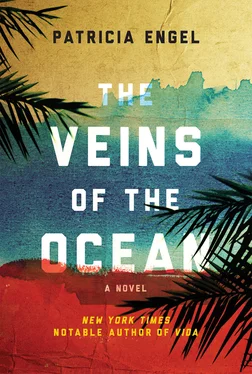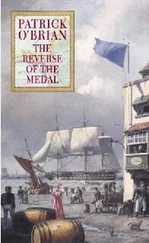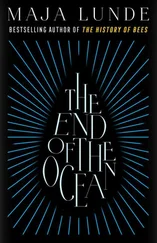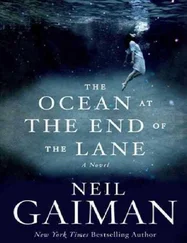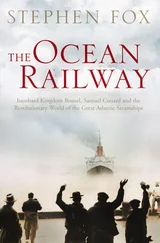Others, he says, come to conjure Ogún who dwells in forests like this one. Some come to place ofrendas at the feet of the Changó’s Ceiba trees — the only tree resistant to lightning and left untouched when the great flood covered the earth, giving shelter to mankind and animals so that life would endure — with bark so potent it can cure infertility: a tree so sacred one should not dare cross its shadow without first asking permission.
Nesto says the bosque is a popular place for small sacrifices, under trees dripping with branches and vines. People arrive to feed the saints with live chickens in cloth bags, leaving behind bloody ones, and nobody, not even one of the guards at the military post across the road, looks twice. At our feet are pieces of broken animal bones, even some chicken claws intact, shards of broken pottery, knotted ropes of all colors, decomposing fruit, and small pools of dried blood staining the soil. In dusty patches on the forest floor are painted white lines and circles among branches and twigs, which Nesto says are interpretations of the cowries, and in the gentle river current, I see sunflowers from upstream glide past us.
It’s because so many come here to meet with the orishas that Nesto says nobody would ever suspect we’ve actually come here to meet with the beef broker.
We watch a man walk down the hill sloping evenly like a set of stairs and make his way toward us on the edge of the river. He’s an older guy, maybe in his fifties, who Nesto told me is a trusted manager of one of the government slaughterhouses, running his negocio by slipping cuts of beef into a briefcase or satchel and taking them on the three-hour drive back to Havana for distribution. There are other men who run the same enterprise for fish, which comes from Africa, unavailable in the island food dispensaries for months, and another guy who brokers the plump chicken breasts meant for tourists, since the only cuts available with the Libreta are bony thighs or legs, and each person is only entitled to up to a pound per month.
The man arrives at our side and presents a newspaper-wrapped bundle to Nesto, who peels back a corner to get a look at the quality, counting six fillets.
“You’re looking at Fidel’s best,” the man tells Nesto. “Canadian Holstein crossed with Indian Zebu.”
A few vultures gathered around a chicken carcass farther down the riverbank seem to have noticed the smell of the steaks and move toward us.
“Not bad,” Nesto tells the meat man. “I’ll take them all.”
He slides a few bills of CUCs into the man’s palm with a handshake.
The beef broker heads back up the hill to his car, but Nesto stalls a bit, wrapping the bundle in a plastic bag he brought with him.
Through the trees I see the afternoon light is starting to dim, casting the forest in a pale golden film, similar to the forest of my dream. I try to picture the fires I saw last night in my sleep, try to feel for a connection.
Nesto walks to the edge of the riverbank, handing me the bundle of beef as he slips off his shoes and steps into the water, getting wet up to his knees. He leans over and dips his hands into the current, pulling smooth round stones off the river floor. He rubs them on his arms and neck, and places them on the ground by my feet.
“Many years ago in Africa, when the orishas watched as the first slaves were being packed into ships to be taken across the ocean, Ochún asked her mother, Yemayá, where they were going and Yemayá told her to a faraway island called Cuba. Ochún begged to be allowed to accompany the Africans on their journey. She didn’t want them to travel alone. This is why we love her so much. And they say if you are alone and wait patiently next to her rivers, you can hear her sing the song her father, Obatalá, taught her, which holds the secret of life. To hear it with your own ears is a special blessing.”
“You and your stories, Nesto.”
“I prefer this history to the one they force on us.”
“So, what’s the secret of life?”
“You don’t know? It’s so simple.”
I shake my head.
“Love.”
He stands in the river, his legs haloed by the current. He waves me over to him. I step as close as I can with my feet still on the hard earth. He cups water into his palms and lifts it to my face so the water drips off my forehead and cheeks.
“For protection.” He lets his fingers linger on the curves of my face, cool with water, running them over my lips, down my collarbone, and over my heart.
With the day’s errands out of the way, Nesto says it’s time to go home. He drives along Quinta Avenida, past former residential palaces turned-embassies and ministries, where police monitor street corners. One has to drive fast, Nesto explains, since the early eighties when a bus crashed into the gates of the Peruvian embassy, killing a guard and opening the doors to thousands of asylum seekers, setting off the events that led to the boatlift. If caught slowing down suspiciously in this area, one can be fined. We pass through Miramar and Nesto points out the aquarium where he worked, and the cafeteria down the road where he says young girls hang around, selling themselves for a few dollars to anyone who comes in for a coffee so they can buy minutes for their cell phones.
“Every time I see them I think of my daughter,” he says. “And I think I have to do whatever it takes to get her out of here before she starts getting offers for her body.”
Soon he turns onto another road and up a long hill where the neighborhood has clearly changed, turning from slick and smooth paved avenues to broken, potholed streets. A barrio of colorless buildings wasted by time and neglect to their original plaster and concrete tones. Houses like blocks haphazardly arranged by a child, built one on top of the other. People walk in the middle of the street. Children carry smaller children. Skeletal dogs sleep belly up in small patches of shade under tin awnings. Garbage accumulates on street corners. There are few trees around here and the salty ocean air doesn’t reach this far up the city slope.
“This is it,” Nesto says. “This is Buenavista.”
We’re not far from the famous Tropicana, where Yutong buses drop hundreds of tourists each evening for a show, or even from the neighborhood where El Comandante is said to live beyond gates in a no-fly zone. But Buenavista is one of the forgotten pockets of the city, Nesto tells me; some sections didn’t even have electricity until a year or two ago.
People wave to him as he rolls the car slowly down the broken road, until he pulls over, parks, and points to a house with metal bars over the front door and windows that reminds me of the house I grew up in.
“This is my home.”
Nesto opens the front door for me and we stand in the entryway as he calls to his mother until she comes down a dark hall toward us. She looks much older than my own mother, more like the sweet abuelitas of kids I knew from our neighborhood in Miami, grandmothers who lit up when their grandchildren came around, so different from my grandmother, who, in spite of her affection for me, often snarled that it was too bad I had the misfortune of being born my mother’s daughter.
Nesto greets his mother with a kiss, then pulls back to introduce me to her.
“This is Reina, Mamá.”
“Reina,” she pulls me to her chest with an embrace, then holds me by my shoulders to get a better look at me as if I’m a long-lost relative and not a total stranger. It’s a warmth I’m not used to. “Welcome, welcome. Estás en tu casa.”
I see Nesto’s smoky eyes in his mother’s. She’s dark as melao de caña like he is, though her face is dotted with freckles. She ushers me into a sitting area with a door open to the patio while Nesto goes out to the car to bring in the food we bought for dinner. I look out to the patio and see the prized trees Nesto has told me about, which fed his family through their toughest times. Beneath the mango tree, the long-haired white cat sleeps: Blancanieves, who Nesto told me he rescued from a dumpster years ago, before someone else could trap her to use or sell for brujería.
Читать дальше
